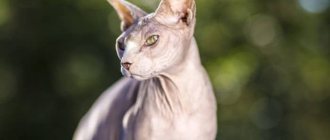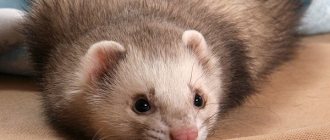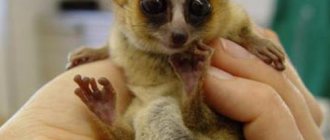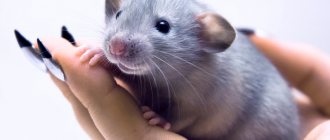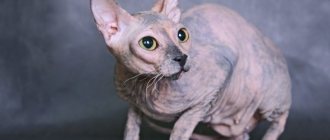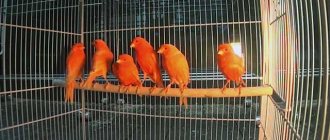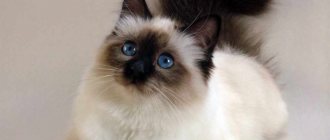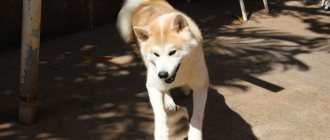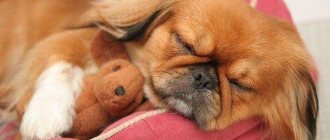Origin story
The Don Sphynx breed was officially recognized in 1997.
The history of the appearance of funny bald kittens stretches back to 1986, when one of the residents of Rostov-on-Don, Elena, took a kitten half-tortured by boys from a chilly street. The baby was named Varvara, and she was so thin and shabby that the owner carried her from clinic to clinic for several months, trying to bring her into divine form. Varvara gained weight, but the new fur stubbornly refused to grow.
They would have left the cat alone, marveling at the previously unprecedented mutation, but the breeder Irina Nemykina continued to be interested in the fate of the amazing cat, and when the latter had kittens, she took one with a sparsely drooping tail, curly paws and a large bald spot on her head for herself.
The female Chita was first matched with a gray-blue cat of the European shorthair breed, then with her own son Hannibal. The first litters had fur: however, over time the kittens shed it, but felinologists were not interested in these individuals.
In the end, the experiment ended in victory. The kittens were officially registered, in 2000 a cat with the proud name Vityaz Myth received the title of WCF champion, and the number of fans of the breed grew noticeably.
The number of individuals gradually increased, and the need to involve “outsiders” in the breeding process.
Bald kittens were periodically born to the most ordinary cats. For example, in 1966, in Canada, the cat Prune (without fur) was brought together with his mother. There were also hairless cats in the litter. However, no one began to seriously breed them.
Don Sphynx
Description
The Don Sphynx is a medium-sized hairless cat.
Males are slightly larger than females. The optimal weight of an adult cat is about 3 kg, and an adult cat is 4-5 kg. The Sphinx has strong bones and developed muscles, and a proportional physique. The limbs are slender, the hind limbs are slightly longer than the front ones, the paws are compact, with long toes. The neck is strong and slender. The head is wedge-shaped, with prominent cheekbones and eyebrows. The eyes are large, slightly slanted, beautiful almond-shaped; can be any color. The ears are large, erect, slightly tilted forward. Forehead with many skin folds. The tail is long and straight.
The Don Sphynx breed has several standards and 4 main types of hairlessness:
- Naked Don Sphynxes. Cats that are completely hairless. Their bare skin is very soft and warm to the touch. This variety is the most valued. Hairless sphinxes are also called “rubber” or “plasticine”.
- Don sphinxes flock. The body of this cat is covered with delicate “fluff” - soft and very short hair. It is pleasant to the touch and almost invisible to the eye.
- Don Sphynxes velor. This group includes cats with short but quite noticeable hair, which disappears with age. As a rule, by the age of 2 years the cat already becomes hairless. Small patches of fur may remain on the face, paws and tail.
- Don sphinxes brush. These cats are partly hairless and partly covered with curly or wavy hair. A very unusual variety. Depending on various conditions (external factors or hormonal levels), the fur becomes either larger or smaller - and so on throughout life. Sphynxes of this variety do not receive prizes at exhibitions, but actively participate in breeding work.
In all four varieties, any color is allowed.
Character
In all the variety of breeds, it is difficult to find a more devoted and affectionate cat than the Don Sphynx. These cats are very sociable, peaceful and sensitive. Their mood largely depends on how much attention their owner pays to them.
The Don Sphynx will never be offended, mischievous, ignore others, or show aggression. He likes to be at the center of events. He loves affection and attention, gets along well with children and other friendly pets.
Representatives of this breed are open and trusting like children. They will be ideal pets for people who value sensitivity, tenderness and devotion.
Health and life expectancy
Don Sphynxes may have hereditary diseases. If you purchase a kitten from a professional breeder, the risk is minimal. Hairless cats are prone to skin problems. They get cold easily or, conversely, overheat. However, with proper care and sensitive attitude of the owners, sphinxes rarely get sick.
How long do Don Sphynxes live? The average life expectancy is 13-14 years.
Care and maintenance
Hairless cats require more sensitive care than their long-haired counterparts. They are sensitive to temperature changes and thermophilic. When the apartment is cool, the Don Sphynx cannot do without special warm clothing. And in the summer heat, you need to make sure that he doesn’t get burned while resting on the windowsill.
The bare skin of sphinxes is not protected by fur. Due to dust and natural skin lubrication, it quickly becomes dirty, and it must be regularly wiped with plain water or using specially selected hypoallergenic products. Blackheads and acne may appear on the skin. This can be corrected with proper care and nutrition. The condition of the eyes and ears also needs regular monitoring.
A hairless cat's body uses more energy to stay warm. That's why Sphynx cats eat a little more than regular cats. Nutrition must be of high quality and balanced.
Caring for the Don Sphynx may seem difficult, but this is only at first glance. In practice, following the rules is not difficult. In addition, the benefits of keeping these cats are much greater. You will not encounter shedding or an abundance of fur throughout the apartment. Sphynxes are naturally very clean and tidy. They do not have an unpleasant odor, do not go to the toilet in inappropriate places, and cats rarely mark their territory. Allergic reactions to Sphynx cats occur much less frequently than to other cats.
Read more about this in the article “Care for Sphynx cats.”
Story
Don Sphynxes are the pride of our country.
The breed was bred in Rostov-on-Don, completely by accident. In the 80s, a kind woman picked up an almost hairless kitten on the street and began to treat it. The kitten recovered, but fur did not appear on its body. Soon the weak kitten from the street turned into an adult cat, Varvara. Varvara later gave birth to kittens from a European shorthair cat, and their skin was also partially hairless.
Felinologists became interested in the unusual litter. Thus began the breeding work. The result was a new prestigious breed - the Don Sphynx. Registered in 1996, it quickly gained worldwide popularity.
Standards
The skin of the Don Sphynx is very elastic and hot to the touch. It gathers in folds in the armpits, groin and forehead. A small amount of hair is allowed on the face and paws of young animals.
Unenlightened people often confuse the Don Sphynxes with the Canadian ones, but the differences between them are enormous.
| Standard | Description |
| Head | Wedge-shaped, with clearly defined cheekbones and a prominent, wrinkled forehead. The muzzle is of moderate length, slightly rounded. The chin is strong and strong-willed. |
| Nose | Straight, medium length. "Stop" is clearly visible. The mustache curls. |
| Eyes | Large, almond-shaped, wide open. Placed a little askew. Any color of the iris is allowed. Color may change with age. |
| Ears | Large, wide at the base, inclined forward, with rounded tips. |
| Torso | Muscular, compact, but wide in the croup area. Middle length. |
| Limbs | Medium, with straight forearms. Paws are elongated. |
| Tail | Long and flexible, without bends or creases. The tip is rounded. |
Based on the structure of their coat, representatives of this breed are divided into several types.
- Rubber (hairless) Sphynx: this cat has no hair on its body. The skin is wrinkled, very warm to the touch, and covered with a sticky coating.
- Flock: The cat's body is covered with a fine coat of fur that has been compared to the fuzz on the skin of a peach. As they grow older, this fur falls out.
- Velor: The fur of this type is slightly longer than that of a flock cat, but it also falls out over time.
- Brush: have the longest coat. It is rare, but tough and curly. They are suitable for breeding, but exhibiting them is prohibited.
Significant defects include entropion of the eyelids and malocclusion (underbite by 2 mm or more). And if the sphinx has too small ears, a short tail or a head of a different, non-wedge-shaped shape, it will not be allowed to participate in exhibition events at all.
Description of the breed
The Don Sphynx cat is not large in size, but at the same time has a muscular body with strong bones. These creatures are very pleasant and warm to the touch. Their body temperature is 38-40 C. In appearance, they are a wrinkled creature with an expressive gaze. Wrinkles can be observed on the face, paws and tail. The weight of the animal is about 3-5 kg for girls and 5-7 kg for boys. Like any breed, Don Sphynxes have a certain standard of appearance. Let's take a closer look at it.
Newborn Don Sphynx kittens have a certain peculiarity: after a couple of days of birth, they already open their eyes.
The head of the Don species is wedge-shaped, slightly rounded. The cheekbones and eyebrows are clearly visible on the muzzle. Vertical folds are clearly visible on the forehead. The nose is straight. The chin is harmoniously developed. The animal has large teeth. Long fangs can be seen from under the upper lip. The ears are set high and slightly rounded at the tip. The eyes are slightly slanted and almond-shaped, small in size. Eye color can be varied. There may be no mustache or eyebrows.
The body of a Don Sphynx cat is strong, muscular and proportional. Due to the difference in the width of the shoulders and hips, the body is pear-shaped. As for the limbs, the hind legs are longer than the front legs, proportional to the body and very long.
As for the skin, the Don species has three types:
- Naked or naked. Newborns have no fur, which is how they deserve their name. They are also called “rubber” because of the similar sensations when touching the skin.
- Velor or flock. The skin is covered with a thin fluff, it feels like velor fabric or peach peel. Whether the Don Sphynx will remain covered in velor or go bald will be decided by the age of two years.
- Brush (from the English “brush” - brush). Cats have coarse fur, more like bristles or fuzz. The Don Sphynx with fur has the ability to periodically lose it and then grow it again. This may be due to a number of reasons: changes in hormonal levels, pregnancy, changes in the season or diet, and other factors.
It is noteworthy that the Don Sphynx of the brush type is not represented in exhibitions. They are intended for breeding. The fact is that naked “dandelions” most often give birth to weak and non-viable offspring.
The color of the breed is recognized to be the most diverse: all colors and their combinations, as well as all types of patterns.
Weight by month
Males weigh much more than females: 6, sometimes 7 kg. The weight of females is 3.5-4.5, maximum 5 kg.
Weight table by month:
| Age | Cat | Cat |
| 1 month | 200-310 gr | 230-410 g |
| 2 | 510-750 gr | 630-820 gr |
| 3 | 1-1.5 kg | 1.2-2.1 kg |
| 4 | 1.3-2.3 kg | 1.7-3 kg |
| 5 | 1.8-2.5 kg | 2.2-3.6 kg |
| 6 | 2.2-3.1 kg | 2.9-4.5 kg |
| 8 | 2.8-3.7 kg | 3.2-5.1 kg |
| 10 | 3.2-4.1 kg | 4.4-5.7 kg |
| 1 year | 3.4-4.2 kg | 5-6.4 kg |
| 2 | 3.6-4.6 kg | 5.5-7 kg |
Estrus and mating
Puberty in female Don Sphynx occurs at the age of six months. But mating has not yet been carried out. An individual is suitable for producing offspring only after the third heat. Males mature at approximately 8 months.
Attention! It is recommended to plan the first mating no earlier than the Don Sphynx turns 1.5-2 years old. It is advisable for the females to go into third heat.
Vaccinations are given before mating. The time for the procedure is calculated so that estrus begins no earlier than 14 days after the vaccine is administered. The female is not bathed before mating, as the male may lose interest in her. Experts warn that if both partners mate for the first time, pregnancy may not occur. It is advisable that mating takes place on the cat's territory. To increase the likelihood of fertilization, the couple is brought together again after a few days.
Signs of pregnancy appear 20 days after sexual intercourse. The female's nipples swell, turn bright pink, and her weight gradually increases. A cat bears offspring for 64 days, but this period may be slightly longer or shorter. Childbirth lasts about a day. One lambing can bring up to 6 babies.
Colors
Don Sphynxes can have any color. Smoky, reddish, bluish, red, white - in general, whatever. Even tabby color is allowed, the only caveat is that cats with this appearance are grouped into a separate subspecies.
In the photo the Don Sphynx colors: smoky, red tabby and white
Character and behavior
The big-eyed sphinx is always happy to show love and affection from his owner, however, he himself does not skimp on them. This fragile little body hides an amazingly kind heart and a gentle soul. The Sphinx is gentle and not jealous, there is no aggression in him and such a concept as “vindictiveness” is also unfamiliar to him. A sort of companion cat, which, however, will not follow its owner’s tail and pester, seeing that the latter is clearly not in the “mood.” The habits of the sphinx allow him to get along well with other animals: cats and small dogs.
The Sphinx would also be happy to make friends with hamsters and parrots, but the hunting instinct sometimes takes over. Therefore, you, as the owner, better be on your guard and not leave this motley company unattended.
Sphynx cats can be called moderately lazy cats: they prefer to doze most of the day, sitting in a warm place near a warm radiator or on the cozy lap of their owner. However, they do not shy away from physical exercise, especially in childhood.
Kids are very curious: they will happily explore the dark corners of the apartment, stick their noses under beds and sofas, try to open the door of the bedside table or climb into the trash can. However, with age, activity gradually declines, and is replaced by slight indifference and serenity.
According to folk wisdom, what should happen if a cat washes itself?
Receive a letter Guests will come
The Don sphinxes are also amazing. Breeders of this breed unanimously praise their ingenuity and intelligence. Dealing with a door latch, for example, is a piece of cake for a sphinx. The same applies to a loosely closed box. A cat can be taught to ring a bell, jump on a doorknob, fetch his toys, follow the commands “come to me,” “food,” “bathe,” and much more. Do you feel what the field is for training? But remember: it is useless to force the sphinxes. He will study only if he is interested, and for this you will have to make some efforts.
In addition to the obvious advantages, the breed also has disadvantages. Firstly, there are frequent problems with the toilet. Sphinxes are quite capable of mastering the litter box, but many owners complain that the pet chooses a place for privacy that is completely unsuitable for this process: the owner’s bed, sofa or rug.
Only your patience and, of course, severity will help you cope with this. Try spraying the area with citrus-scented essential oil or laying an oilcloth over the area (cats don't like the smell of either).
Secondly, claws pose a certain danger. The behavior pattern of sphinxes does not develop for quite a long time, because of this, not only the wallpaper on the walls and furniture suffer, but also the legs of those around them. Yes, and lack of attention can have this effect. Therefore, small children should not be allowed near sphinxes, and the animal needs to buy more toys and a special play complex for climbing.
Character
This is a pleasant, sociable, friendly cat, not only towards people, but also towards other pets. Although adult cats may not get along well with other cats, it all depends on their character.
Affectionate and sociable, they should not be left alone; if you spend a lot of time outside the home, it is better to keep them together.
These cats are friendly and good-natured, they are also intelligent, active, and spend most of their time on the move.
Most of them tolerate procedures such as nail trimming, bathing and veterinary checks. They scratch and bite much less than other cat breeds, making them well suited for families with children.
Care instructions
It would seem that there is no fur on sphinxes, which means that this item on their list of mandatory grooming procedures can be crossed off. But no matter how it is!
Leather
Instead, the skin of Don Sphynxes secretes a brownish lubricant that needs to be cleaned off regularly, and in addition, they also sweat. Moreover, sweat has a sharp, specific smell. Therefore, cats of this breed should be bathed at least once a week, adding a fresh decoction of chamomile or chamomile to the bath. The water temperature is no higher than 40 degrees. It is allowed to use special shampoos for hairless cats: for example, Ms.Kiss “Graceful Sphinx”. On other days, plaque is removed with wet wipes (without alcohol) or a damp cloth.
In the photo there is a cat of the Donskoy Sphynx breed
Eyes
Sphynxes do not have eyelashes, so the eyes become another “weak” point of these cats. Wipe them daily with a cotton swab soaked in eye lotion (Cliny), fresh chamomile infusion, or chlorhexidine.
Ears
Locator ears also require care, as wax regularly accumulates in them. Use a cotton swab, but don't try to push it too deep, otherwise you risk deafening your pet's hearing. For the same reason, there is no need to pour anything into the ear.
Claws
Sphinxes know how to sharpen their claws, but the specific structure (they are so long that they do not “retract” completely into the pads) requires human help. The nail bed is regularly cleaned with a cloth soaked in chlorhexidine, and once a week the nails are trimmed using a nail clipper. But be careful: do not touch the nerve endings and blood vessels.
Teeth
It is enough to brush the Sphynx's teeth 3-4 times a month, using a special paste for cats and the same brush. Both can be purchased at a pet store.
If your cat does not want to brush his teeth at all, you can apply a special dental gel to his mucous membranes or gums, or drip liquid paste into drinking water. Dry food for cleaning teeth also brings certain benefits: pads, granules and sticks made from veins and bone particles.
Expert opinion
Dusheba Vera Ivanovna
In 2010, she graduated from the Moscow State Academy of Veterinary Medicine named after K.I. Scriabin with honors, specializing in veterinary medicine. I regularly attend veterinary conferences, congresses, and webinars.
Sphynxes, like no one else, love to bask in the sun, but excess ultraviolet radiation threatens sunburn on delicate skin not protected by fur. Don't let your cat roam around in the sun.
Care and maintenance
Caring for the Don Sphynx requires special conditions. This is due to the peculiarities of the animal’s heat exchange, which consist of the absence of fur and increased body temperature. If a kitten ends up in a home where there are other animals, it is recommended to isolate it for several weeks for safety reasons. These animals are sensitive to changes in environmental temperature. It is worth taking this into account, especially during the off-season, when the apartment has already become cool, but the heating has not yet been turned on. Many owners buy clothes for this or turn on the split system in heating mode.
In general, all hairless cats do not need walking and feel great all their lives in an apartment, without contact with the outside world. You also need to know that the skin is exposed to ultraviolet radiation. The cat should not spend a lot of time in the sun, as it may get burned. Many owners note the increased appetite of these animals, which is dictated by their fast metabolism, which also depends on heat exchange. The animal is forced to spend a lot of calories to maintain its optimal body temperature.
The Don Sphynx must receive food at least 3 times a day, but adhere to certain diet rules. Like any other cat, it is necessary to monitor the condition of the eyes, ears, and teeth. Due to increased secretion of the glands, the cat needs to be bathed at least once every 10 days, preferably every week.
Catering
Sphinxes have 2 features: increased heat transfer and accelerated metabolism. Both the first and second require special attention to the cat’s diet, so you should feed it not 2 times a day, but 3-4.
Natural products
The main menu of the Don Sphynx should include:
- Lean meat. These are veal, beef, chicken, rabbit, turkey, lamb. Per day - at least 150 grams. There is no need to boil the meat, just pour boiling water over it.
- By-products: chicken necks, gizzards, liver, lungs, hearts. The liver is boiled, the rest can be given raw. Offal is given instead of meat a couple of times a week.
- Fish fillet from sea fish: salmon, halibut, sturgeon, pike perch, trout. You can’t feed fish more than once a week: too much of it can trigger the development of urolithiasis.
- Porridge from cereals: buckwheat, millet, rice, oatmeal, pearl barley. Given every day. Add a few drops of oil (sunflower, corn, flaxseed, olive) to the porridge.
- Fermented milk products: yogurt, kefir, natural yogurt, cottage cheese, bifido products. Everything is low-fat, without dyes, preservatives or additives harmful to the animal.
- Chicken and quail eggs (boiled; chicken eggs yield only the yolk).
- Vegetables: pumpkin, lettuce, dill and parsley, zucchini, beets. They are boiled or stewed.
- Sprouted oat or wheat sprouts.
Babies and old animals can be fed with meat baby food and liquid semolina porridge with milk.
It is forbidden to give cats:
- Offal, bones, lard, fat;
- Fatty meat (pork, geese and duck);
- Whole cow's milk;
- Sweets, baked goods, smoked foods, human canned food;
- Alcohol, juices, mineral water, coffee, tea;
- Flour;
- Sausages, sausages;
- Legumes, cabbage, avocado, grapes, bananas, onions, garlic.
- Condiments, spices, mayonnaise, sauces.
Recommended food
Of the industrial foods, only holistic foods are suitable: they do not cause allergies, and Sphynx cats often suffer from them. List of the best foods: Carnilove, Pronature Holistic, Primordial.
Below are the recommended holistic class foods. Links with the names of the food are clickable, on them you can, within our website, get acquainted with the descriptions of the food and read reviews from owners of Don Sphynx cats.
| Holistic | Holistic | Holistic |
| Canagan | Wellness CORE | Wildcat |
Teach your animal to eat in the same place, preferably at the same time. At 3 months (and younger kittens) they eat 5-6 times a day, gradually the number of feedings is reduced to 3-4 times. The water in the drinking bowl is changed in the morning and evening. Food should be comfortable, not from the refrigerator, but not hot either.
In the photo there is a cat of the Donskoy Sphynx breed with her kittens
Diseases
Good health to the Don Sphynxes - alas and ah! – they can’t boast. Predisposition to diseases is caused by errors in breeding and is inherited. But, of course, improper care also affects it.
The following ailments are typical for sphinxes:
- Underdevelopment of the thymus (another name is kitten falling asleep syndrome). The pathology is a side effect of incest and, unfortunately, cannot be treated. Babies live very little: 5-10 days, with cyanosis and dryness of the extremities and dehydration.
- Curvature of the tail. Often, along with this pathology, the kitten is diagnosed with intestinal pathology and lack of growth. This disease is caused by crossing related cats.
- Vasculitis is an immunopathological inflammation of the walls of blood vessels. The mild form may go away on its own; in more severe cases, drug treatment is required.
- Malocclusion (“carp”): occurs at the stage of fetal formation. With this disease, the lower and upper incisors do not align.
- Microphthalmos: eye pathology. This may be myopia, blindness, cataracts, congenital keratitis, Colombo.
- Hyperplasia of the nipple, mammary gland. It occurs more often in light blue and cream colored cats. It is extremely rare for them to have healthy offspring.
Cats without fur are susceptible to colds. Laryngitis, rhinitis, bronchopneumonia, pleurisy are quite common.
Breeding cats with diseases such as entropion of the eyelids, softening (curvature) of the spine, nipple hyperplasia, microphthalmia and pathological shortening of the lower jaw is prohibited!
Video
* We invite you to watch a video about the Don Sphynx . In fact, in front of you is a playlist in which you can select and watch any of 20 videos about a given cat breed by simply clicking on the button in the upper right corner of the window. In addition, the material contains quite a lot of photos. By looking at them you can find out what the Don Sphynx looks like.
In this article:
|
Rate the material!
[Total votes: 0 Average: 0]
The Don Sphynx is an animal endowed with special charm and beauty. Some consider him ugly, but among true cat lovers there are many admirers of the breed. Don Sphynxes have a soft, affectionate character and an elegant appearance. They are very playful and can create entertainment out of nothing. They get along well with guests and other pets.
Advantages and disadvantages
- High intellectual abilities.
- Affectionate.
- Playful.
- They treat children well.
- Not vindictive.
- No fur, no shedding.
- Suitable for training.
- Do not iron, the skin is very sensitive.
- Due to the high temperature, they “sweat” a lot.
- Complete dependence on a person.
- They hardly chew food; it is necessary to monitor the size of food pieces.
- They eat more than other breeds.
- Demanding on ambient temperature.


